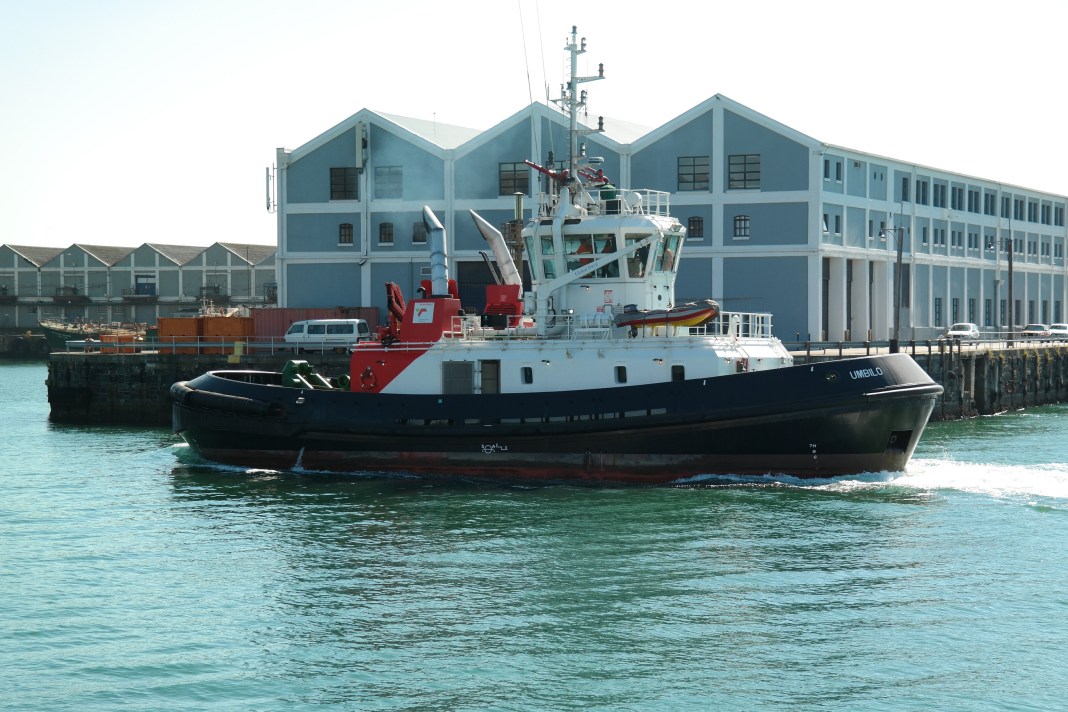Over the past few days residents of Sea Point, Green Point and Mouille Point – and even a few as far away as Oranjezicht – have been kept awake by the nighttime sound of heavy rumbling; the deep diesel growl of an engine which seemed to come from everywhere and nowhere; from inside the earth, itself. Eventually, the source became known: a backlog of container ships lined up across Table Bay were anchored and waiting to enter Cape Town harbour. But with a storm on the way bringing huge and dangerous swells, the pressure was on to get these freighters into port. The noise that reverberated through the sleeping city was of the tugs working day and night to tow these giant vessels to safety.
Many homes on the Atlantic Seaboard command an unbroken view of the coastline along which these enormous ships sail, and their arrival and departure from our shores is inextricably tied up in the history of South Africa. As maritime traffic increased and the treacherous nature of our rocky coastline with its notorious winter storms saw many ships running aground, a lighthouse was constructed in Mouille Point. This was the first solid lighthouse structure on the South African coast, and it is the oldest operational lighthouse in South Africa. Designed by German architect Herman Schutte, it was first lit on 12 April 1824 with Argand lamps fueled by sperm whale oil. The light from these lanterns could be seen for six nautical miles, and it was a welcome warning beacon for ships nearing the port.
But many were less fortunate. A visitor to the promenade in Mouille Point who looks out to sea will notice a strange object sticking out of the water barely 85 meters from the shore. This man-made metal structure forms the remains of the engine block of the ill-fated Royal Mail Steamer, Athens, which ran into difficulty in May 1865, almost exactly 155 years ago and likely in a similar storm to what we saw last week. While this ship was one of 17 that ran into trouble that evening, what makes this story so poignant is how close the vessel was to land. Residents built a bonfire on the beach and could hear the cries of the sailors, but the thrashing waves and churning seas made any rescue attempt impossible. By the time morning broke all had gone quiet, and 28 men lost their lives on that dark and fateful night. The rusty remains are an eery reminder of the dangers that lurk when the weather turns against us.
When fog rolls in, the seafront takes on a moody, ghostly demeanor, compounded by the plaintive wail of the foghorn as it echoes across the bay. The foghorn was installed as an extra safety measure in 1926 despite letters of complaint issued to the Mayor of Cape Town by Green Point residents bitterly unhappy about the noise. Dubbed ‘Moaning Minnie’ by locals, its sound is as much a part of the area as the screeching gulls and the south-easterly wind that whips the waves into a frenzy. Its wail conjures memories of years gone by, like the dark July night in 1965 when heartbroken poet Ingrid Jonker walked, fully, clothed, into the icy waters of Three Anchor Bay. Her body washed up on Clifton beach the following day.
There is a cold, gloomy room in the lighthouse which is rumoured to house a ghost. The specter of a lighthouse keeper by the name of W.S. West (or, ‘Daddy West’ as he was known) who manned the lighthouse around the turn of the century has apparently been seen on numerous occasions by lighthouse staff. One night in 2014 the Cape Town Paranormal Investigations Unit set up cameras and tried to communicate with the spirit. While nothing of a visual nature was captured, a playback of the video reveals an auditory anomaly — a disembodied voice captured on film can be heard clearly whispering ‘up here’ in response to requests that he make his presence known. Could be nonsense; could be that he loved that lighthouse and wasn’t leaving anytime soon. Whatever the case, the red and white striped building has become an iconic part of the landscape, and if it could talk it would have some extraordinary tales to tell.
Winter settled in early this year. After a long, warm autumn the sudden cold snap which brought snowfall to high-lying regions of the Western Cape took many by surprise, and the high winds and heavy rain have had us battening down the hatches. From the vantage point of the Atlantic Seaboard the weather has been wild and magnificent, thunder bouncing off the mountain and lightning flashing over the sea. Meteorologists are predicting that we are in for a rough season. In more ways than one it will be a winter of riding out the storm.
Lance Real Estate is based in Fresnaye, Cape Town and covers the Atlantic Seaboard from the Waterfront to Camps Bay. With over 23 years’ experience in the most sought-after residential areas in Africa, Lance Real Estate has sold over R 1 billion worth of properties in the last 3 years.
It is this hands-on knowledge that sets Lance Real Estate apart from our competition. We have built an extensive database of buyers and sellers over the last 2 decades who have grown to trust our market knowledge and depend on us to negotiate the best possible deal in any property negotiation.
We are now extending our reach and taking on houses and apartments for sale from the Waterfront through to Camps Bay.
If you are looking for a remarkable agency to buy, rent or sell your property on the Atlantic Seaboard, our friendly customer care team is a phone call away.
We also have a range of holiday rentals to offer. If you appreciate beautiful African sunsets over the sea and sublime mountain views, then visit our holiday rentals section on our website.
Contact
Email: info@lancerealestate.co
Tel: +27 82 416 6103
Website: http://www.lancerealestate.co
#lancerealestate #capetown #capetownproperty


